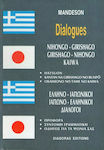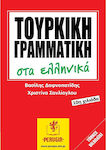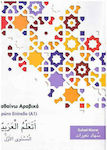Skroutz Buyers Protection
Γραμματική της ιαπωνικής γλώσσας με ασκήσειςCode: 18651195
- Author: Κατερίνα Λέφα
- Publisher: Germanos
- Μορφή: Soft Cover
- Έτος έκδοσης: 2019
- Αριθμός σελίδων: 296
- Κωδικός ISBN-13: 9786185389048
- Διαστάσεις: 24×17
Similar products









Language Learning Books
ΤΑ ΚΙΝΕΖΙΚΑ ΣΕ ΑΠΛΑ ΕΛΛΗΝΙΚΑ – ΒΙΒΛΙΟ ΜΑΘΗΤΗ + CD ΤΟΜΟΣ 1ΟΣ 2Η ΕΚΔΟΣΗ
from 148,87 LeiAdded


All shops
Prices are calculated for:Romania, Other Payment Options
- 113,45 Lei
- 113,45 Lei
- 113,45 Lei
- 106,78 Lei
- 106,72 Lei
- 133,47 Lei
- 123,25 Lei
Description
This book aims to facilitate students of the Japanese language in understanding basic Japanese grammar and to bridge the differences that exist between the two languages. It serves as a practical aid for students who are beginning their study of the Japanese language and covers the grammar taught at the beginner level.
Specifications
- Language
- Japanese
- Format
- Soft Cover
- Number of Pages
- 296
- Publication Date
- 2019
- Dimensions
- 24x17 cm
Important information
Specifications are collected from official manufacturer websites. Please verify the specifications before proceeding with your final purchase. If you notice any problem you can report it here.
Reviews
Reviews photos
Reviews by our members
The book is very good. It contains examples and exercises that help a lot in understanding what it teaches. At the end of the book, there are the hiragana and katakana scripts for those who do not know them to study. You need to learn them first in order to be able to read it.
There are some typographical errors and some in the Greek translation.
I suggest you buy both the Greek-Japanese and Japanese-Greek Dictionary by Vasilis Korakianitis. It will help you a lot in learning the Japanese language.Translated from Greek ·- Paper quality
- Content Understanding
- Effectiveness
- I would recommend it for purchase
Did you find this review helpful?(Warning: something more than a review lol)
It's very good!!
GENERAL OBSERVATION:
It does not contain Rōmaji writing (convenient, but if you get used to it, you will only read that and struggle with Kana)!! (Bravo to the author for not preferring it!!)
Instead, she chose another more convenient one called Furigana!The book is aimed at N5 & N4 level students.
CONTENT:
1. Well-structured
2. Grammar, written in detail, correctly, and easy to understand! (But not everything... Below, I mention which are the gaps created by the author)...
Indeed, it facilitates everyone who has started learning Japanese! However...*GENERAL OBSERVATION 2:
You need a basic vocabulary level to understand the exercise examples... After all, it is a grammar book, not a dictionary or something similar!
Therefore, even as a beginner, you need to know words, Kana writing... and maybe some Kanji... even though when you can't read them, she writes them in Hiragana/Katakana... If you don't know Kana writing, go to the chapter titled "Appendix," pages 278-279 :-)
+At the end of the book, there are the exercise solutions!!PERSONAL OPINION:
I do not recommend the book for self-study, for those who have no knowledge of the language because (for example) the particles will confuse you!!(To help some who had/have the same comprehension problems as me when I read the book, see below):
NEGATIVES:
1. [Personal Opinion] I don't really like the red color they used as the main color to highlight the notes that may contain examples... It hurt my eyes to read them (because they were too intense)!... But you may not have such a problem like me...2. [Minor Typographical Errors]
a) Page 13, exercise 1, 3rd sentence at the end... it should have been です... it was てす...
b) Page 14, in the も particle, 3rd sentence... it had the verb 行きます above the ideogram 行... it did not have the Furigana writing.
(These are the ones I found for now... as well as the ones below...)3. [Serious Errors or Errors that confuse comprehension]
A) Exercise solutions, page 283, exercise 6, 1st sentence, the で particle should be in its place... but they didn't draw a line.B) Page 17... in the note, the の particle can also be used because: when the sentence is relative and can be translated as "the one/whose // that," then, besides が, the の particle can also be used.
In the appendix, page 264, it somewhat mentions it... but I don't know if it will be understandable for everyone...C) Regarding the に particle:
2nd bullet point (Yes, I marked them with bullet points to differentiate the cases)1. It focuses on the destination of the action or movement of the verb. (e.g. I go to SCHOOL)
2. It indicates destination and accompanies words that indicate place and time, and motion verbs (I mainly refer to the 2nd example that uses time and place/destination)
3. In the last bullet point, the examples are correct but they don't say anything on their own... In other words, when I read them, I said:
And how do I know that getting on the bus (referring to the 2nd example) is the point of arrival, since I can say "and I got off the bus" afterwards??? In other words, the examples could very well be used for the starting point as well... Therefore, it should say, for example, in the 2nd example I mentioned, that it is part of the dialogue and that within a complete sentence it would be:
e.g. Initially, I crossed the road, then I went up the sidewalk and FINALLY, I got on the bus (Terminus)!
(The same applies to the page that talks about the starting point)D) The difference between へ and に:
It indicates direction and/or destination, and goes with a motion verbDIFFERENCE:
1. へ is less flexible but clearer than に, regarding direction (in the movement/action of the verb)2. へ is used more in formal speech than in casual, and for this reason, に is preferred most of the time!
3. Focuses on the Direct OBJECTIVE DIRECTION and not the specific one. (e.g. heading towards Tokyo (Generally/Overall))
4. Emphasizes the direction of the destination! (e.g. GOING to school)
5. Indicates the direction of transportation means (not for N5 level this... I just wrote it so that everyone knows)
In conclusion, we could say that they are somewhat similar to は and が, where に and が focus on the object (what exists before に/が), while へ and は focus on the subject of the sentence (は) / action of the verb (へ (motion verb)).
(In other words, whatever comes after the subject, etc. (and the は or へ particle is placed in front of them))
In the book it said:
に indicates destination and is used with a motion verb... and the particle へ indicates direction or destination, and is also used with a motion verb... Correct, but I don't know how understandable it is for someone who has just started learning Japanese >﹏<... That's why I said the above, and I hope I covered you... Of course, as you read what I said, you should also see the examples in these two particles, to understand the differences... Of course, for the example in the へ particle... it doesn't mean that the に couldn't be used in its place... (That's why I didn't like the example given by Ms. Lefa)!
But you should know that に focuses on the destination and not so much on the motion verb... While へ does exactly the opposite, that is, it focuses more on the motion verb!
Nevertheless, I assume that Ms. Lefa took into account the fact that most of the time, these two particles can replace each other, and that's why she used similar examples! In other words, most of the time you can choose whichever you want!E) Page 23... に==> Never に: (First Volition)... Hmm, the words "tomorrow, last year" are not present tense words... She made mistakes in the translations... She writes from right to left: "Today", "Tomorrow", "Last year, etc"... These belong to the category of "Indefinite Time"... But, the words she actually gives are present tense words, just the translations are wrong and confusing. Therefore, it should be like this: 今日、今週、今月、今年 ===> "Today", "This week", "This month", "This year"
Z) Page 19, exercise 4, example 13:
Sentence B is incomplete. That is, it does not explain to us why it refers to the rain. Why not use が instead of は? Even if it is は, as stated in the book's solutions, shouldn't there be continuity in the sentence? Being a beginner, I cannot understand the use of は here... Seeing it, I thought that the speaker refers to new information and focuses on it (which is the subject)... therefore, I say, it needs が (but apparently it is not like that...) In conclusion, the sentence should have been complete for the reader's understanding!
It should say:
e.g. It doesn't seem to rain, but the weather is not good.GENERAL OBSERVATION 3:
Whatever you don't understand, the examples of the exercises for each grammar really help a lot!! (e.g. in the particles に, で... maybe even へ and を, on pages 20 and 22)GENERAL OBSERVATION 4:
Something very important, in the book there will be many grammar phenomena that coincide with each other, e.g. in the last rule that talks about the particle に and says that it indicates the indirect object, in the example with the teacher (it shows in the last image I uploaded) that the particle に is used... I don't know about you, but I am full of questions and because I don't learn Japanese with a teacher to ask him/her if in the place of に, in this example, we could use the particle が... I go to HiNative and ask questions to native speakers of the language! So, for those who are learning Japanese on their own, let them have, for example, HiNative to help with the questions they may have!GENERAL OBSERVATION 5:
This book was created together with the program ''Japan Foundation''!! Which means... that it is a very good book... just what you need for learning Japanese for beginners... So, if you search for it, you will see that some of those renowned books, which are also good, have contributed to their realization and the ''Japan Foundation''!! How cool and nice is that?GENERAL OBSERVATION 6:
Although I don't go to the ''SPEAK'' tutoring center to learn something extra (or to ask something I didn't understand)... This book contains everything for the preparation of levels N5 & N4 and doesn't confuse you much (almost at all) like some other books!! I'm more than glad to have bought this book!!!╰(*°▽°*)╯EPILOGUE (FINALLY):
That's all I had to say... I hope Ms. Katerina Lefa will write more books for levels N3, N2, and N1!!
Thank you to those who put up with me UNTIL THE END! (Hahaha!!! Sorry for the rant!!)
I wish you happy reading!!!Translated from Greek ·- Paper quality
- Effectiveness
- I would recommend it for purchase
- Content Understanding
Did you find this review helpful?Verified purchase
- Paper quality
- Content Understanding
- Effectiveness
- I would recommend it for purchase

















